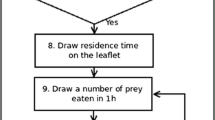Summary
An acarine predator-prey system in a circular stepping-stone environment was described with a simulation model to elucidate the factors responsible for persistence of the system. The main assumptions in this model are: (1) The prey are inevitably eliminated in patches in which predators exist. (2) The density of prey declines and becomes extinct by plant defoliation due to feeding by prey. In this regard this model is different from the models which mimickedHuffaker's (1958) experiments and assumed stable plant-prey relations.
Analyses showed that the critical factor in persistence of the predator-prey system was the plant-prey relations, at any combination of other parameters involved in the model. The predator-prey system did not persist long under the unstable relationship of prey and plant. Otherwise the system persisted longer especially when I used a larger number of patches, a larger amount of plant in each patch, and long-distance-migrations of the prey. In particular, frequent emigration of the prey regardless of plant conditions was most effective.
Similar content being viewed by others
References
Fujita, K., T. Inoue, andA. Takafuji (1979) Systems analysis of an acarine predator-prey system. I.Res. Popul. Ecol. 21: 105–119.
Gurney, W. S. C. andR. M. Nisbet (1978) Predator-prey fluctuations in patchy environments.J. Anim. Ecol. 47: 85–102.
Hilborn, R. (1975) The effect of spatial heterogeneity in the persistence of predator-prey interactions.Theor. Popul. Biol. 8: 346–355.
Huffaker, C. B. (1958) Experimental studies on predation: dispersion factors and predator-prey oscillations.Hilgardia 27: 343–383.
Maynard Smith, J. (1974)Models in ecology. Cambridge University Press, Cambridge.
Takafuji, A. (1977) The effect of the rate of successful dispersal of a phytoseiid mite,Phytoseiulus persimilis Athias-Henriot (Acarina: Phytoseiidae) on the persistence in the interactive system between the predator and its prey.Res. Popul. Ecol. 18: 210–222.
Takafuji, A. andD. A. Chant (1976) Comparative studies of two species of predacious phytoseiid mites (Acarina: Phytoseiidae), with special reference to their responses to the density of their prey.Res. Popul. Ecol. 17: 255–310.
Takafuji, A., T. Inoue andK. Fujita (1981) Analysis of an acarine predator-prey system in glasshouse.Proc. 1st Japan/USA Symp. on IPM: 144–153.
Takafuji, A., Y. Tsuda andT. Miki (1983) System behaviour in predator-prey interaction, with special reference to acarine predator-prey system.Res. Popul. Ecol. Suppl.3: 75–92.
Yasuda, M. (1979) Ecological studies on the reproduction and dispersal of the citrus red mite,Panonychus citri (McGregor).Appl. Ent. Zool. 14: 310–318.
Author information
Authors and Affiliations
Rights and permissions
About this article
Cite this article
Fujita, K. Systems analysis of an acarine predator-prey system II: Interactions in discontinuous environment. Res Popul Ecol 25, 387–399 (1983). https://doi.org/10.1007/BF02515611
Issue Date:
DOI: https://doi.org/10.1007/BF02515611




